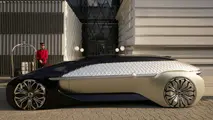Lotus unveils first all-electric British hypercar
UK sports car manufacturer Lotus has unveiled the Evija, a vehicle claimed to be the the lightest and most powerful pure electric hypercar ever to go into series production.

UK sports car manufacturer Lotus has unveiled the Evija, a vehicle claimed to be the the lightest and most powerful pure electric hypercar ever to go into series production.
The first new model from the group since China’s Geely Auto took a controlling stake in 2017 the vehicle, which has a target output of 2000PS and 1,700Nm of torque, has been designed and engineered in the UK and will be produced at the firm’s headquarters in Hethel, near Norwich.
The car – which is capable of 0-62mph (0-100km/h) in under three seconds and has a top speed of more than 200mph – is the first Lotus road car to feature a one-piece carbon fibre monocoque chassis and also the first to feature an electrified powertrain.
Developed by Williams Advanced Engineering, the engineering services arm of the prominent racing team, the 2,000kW lithium-ion battery pack is mid-mounted immediately behind the two seats and supplies energy directly to four powerful e-motors. Power is fed from the battery pack to a bespoke in-line axial arrangement of two high-power density e-motors.
These feature integrated silicon carbide inverters and epicyclic transmission on each axle of the four-wheel drive powertrain.
Meanwhile, four compact, single-speed, helical gear ground planetary gearboxes transfer power to each driveshaft. Measuring 100mm in depth, each gearbox comes packaged with the e-motor and inverter as a single cylindrical Electrical Drive Unit (EDU). These e-motors enable torque-vectoring, which can instantly distribute power to any combination of two, three or four wheels within a fraction of a second.

The car’s range is 250 miles (400km) on the WLTP Combined Cycle, or 270 miles on the NEDC Combined Cycle and, using existing charging technology, the battery can be fully charged in 18 minutes. Looking ahead, it has the ability to accept an 800kW charge which the firm claims will reduce this to just nine minutes.
The vehicle also boasts a number of innovative aerodynamic features, perhaps most strikingly the use of a Venturi tunnel through each rear quarter. According to Lotus, this aids the delivery of high-energy air flow to the rear of the car which counteracts the low pressure behind the car to reduce drag. Furthermore, the Venturi effect inside the tunnels pulls air through the rear wheel arch louvres, maintaining air quality in the diffuser.
“We studied how Le Mans race cars use air flow creatively to go over, under and around the vehicle, but also through it,” commented Lotus design director Russell Carr. “This concept of ‘porosity’ is key to the Evija and has enabled us to create a timeless design with exceptional amounts of downforce.”
Another key aerodynamic feature is the use of active aerodynamics in the form of a rear spoiler which elevates from its resting position flush to the upper bodywork, and an F1-style Drag Reduction System (DRS) both of which can be deployed either automatically or manually.

Commenting on the launch of the new car, Lotus CEO Phil Popham said: “Evija will re-establish Lotus as a leader in terms of engineering and design. It is a hypercar that is built ‘For the Drivers’.”
The company said it plans to produce a maximum of 130 of the vehicles, which will cost upwards from £1.7m each.



